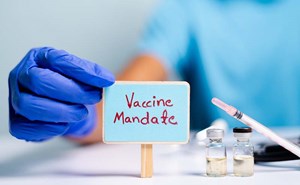No, I haven’t watched every episode of Game of Thrones (sorry to disappoint), but I do understand the significance of the catchy phrase, “Winter is coming,” in the context of our already overburdened health care system. Public health experts, including senior officials in the Biden Administration, are worried about the influx of COVID cases mixed in with the other respiratory illnesses that hit every winter—and are trying to get prepared now by increasing our collective ability to do more testing and treatment and by promoting both the COVID and the flu vaccines.
I don’t have to tell you that you as emergency physicians will most likely bear the full brunt of this winter surge—and based on the current state of affairs in emergency departments (EDs) across the country, its unclear how you all and the system at large will be able to handle it. Thus, it is important for emergency physicians to have a seat at the table to discuss the challenges that we are currently facing, as well as the issues will likely need to address going forward. Earlier this week, ACEP President, Christopher Kang, MD, FACEP, had the opportunity to express concerns and present some policy options directly to senior officials from the Biden Administration. Specifically, on Monday, Dr. Kang participated in a White House roundtable discussion with Dr. Ashish Jha, the Biden Administration’s COVID-19 Response Coordinator, Dr. Vivek Murthy, the Surgeon General, and Dr. Robert Califf, the Commissioner of the Food and Drug Administration. Other physician leaders from across the house of medicine also participated.
While this meeting represented just the beginning of the efforts both the White House and the physician community will collectively take to prepare for the winter (and I will provide future updates on those actions), the points that Dr. Kang raised during the meeting truly represent the major threats that we as a nation are facing—and are issues that the White House really needed to hear about.
Before addressing COVID testing, treatment, and vaccinations, one main issue that Dr. Kang brought forward was the capacity constraints that EDs are facing and the ability to handle additional patients that may seek care for COVID and other respiratory illnesses later this year. Simply put, he said that ED “boarding” and overcrowding must not be overlooked, as it adversely impacts every aspect of health care: access, wait times, delays in care, staffing shortages, burnout, and the inability to discharge patients from hospital.
Over a year ago, I wrote a regs and eggs blog post about how bad ED overcrowding and boarding was, and the situation only gotten worse (actually, much worse!). Recent research from Alexander Janke, MD, MHS et al., demonstrates just how bad things have become. Major indicators associated with boarding (hospital inpatient bed occupancy rates, median boarding time, and left without being seen) have all gone in the wrong direction over the last couple of years. The increase in boarding is due to a confluence of factors, with the most recent challenge being the growing staffing shortages that in part can result from, and then exacerbate further, burnout after a very difficult two years on the front-lines.
Dr. Janke et al.’s studies reflect patterns and data as of the end of last year. To get a better sense of what is happening in our EDs currently, ACEP also conducted a poll this past week of almost 200 respondents. The results are quite striking (though unsurprising):
- 97 percent of emergency physicians responding had boarders in their ED on their last shift.
- About 75 percent had more than 25 percent of their beds filled with boarders and 27 percent had more than 50 percent.
- The median number of boarders per institution was 18 with 6 percent reporting more than 40 patients boarding.
- 47 percent of respondents stated that their EDs are now boarding children.
We also have been hearing some pretty dramatic individualized stories, including recently a nurse in Washington state calling 911 to ask for help triaging patients in the ED. Also, anecdotally, our members have told us that average ED wait times are exponentially longer than they have been historically, with some ranging between 6 and 8 hours or even longer!
ED boarding and overcrowding is a clear and present danger to the stability of our health care system and the continued ability of the ED to serve as the nation’s safety net. We have presented some solutions to government officials in the past, including those at the Centers for Medicare & Medicaid Services (CMS). These included ideas such as having CMS establishing new standards for prompt transfer and hospital bed utilization as well as improving real-time tracking of key indicators that will show the availability of inpatient beds, inpatient psychiatric beds, intensive care unit beds, pediatric beds, and Extracorporeal Membrane Oxygenation (ECMO) machines.
However, given the complexity of the issue and the number of stakeholders involved in any kind of effort to address it, Dr. Kang recommended as a first step in the White House meeting that the White House host a summit on ED boarding and workforce issues that would bring together key stakeholders from the clinician, hospital, nursing home, emergency medical services (EMS), and patient communities to discuss potential solutions. We hope that the White House ultimately decides to host this summit.
Beyond ED boarding, Dr. Kang did raise other important considerations regarding the ED’s role the testing and treatment of COVID and in the promotion and administration of vaccinations. With respect to vaccinations, Dr. Kang commented on the increase in vaccine hesitancy that he’s seen as well as the reluctance among the broader population to take other preventive and safety measures, including wearing masks. EDs can and have provided COVID vaccinations and have routinely vaccinated for other diseases including tetanus and the flu. Last year, a large number of EDs chose to give the COVID vaccine during the actual ED visit. In a group of 153 hospitals reporting to ACEP during a roughly 6-month timeline in mid-2021, there were nearly 17,000 doses of vaccine administered in the ED with only 12 cases of vaccine hesitancy and two instances where staff were too busy. The ED can also be a good place to reduce vaccine hesitancy as a result of the unique relationship and trust you all can often build with your patients during what is a stressful time for them. However, the lack of capacity and staffing shortages could affect the ability of EDs to administer vaccinations going forward.
Regarding the treatment of COVID-19, there have been successful ED-based programs for monoclonal antibodies and remdesivir, where all surrounding EDs sent patients to a central location. However, there are many barriers to the success of these programs, many of which are purely administrative and bureaucratic. Each hospital seems to have a different protocol or process in place for obtaining approval for these treatments. Hospitals and health systems also are acting like these treatments are in short supply when they are not. This is not 2020 or 2021 when supply was an issue. Thus, despite the greater access to medication, we still need more education for clinicians, pharmacists, and hospital administrators. We also need material that patients could have access to in the ED and at home to combat misinformation.
Dr. Kang also recommended that algorithms be developed to streamline the prescribing of Paxlovid and adjuncts. Instead of having to consult with numerous other stakeholders, including infectious disease, nephrology, and pharmacy in order to prescribe medications, there should be a way that you as emergency physicians could bypass those administrative roadblocks by adhering to simple protocols that could be built into an app or the electronic health record (EHR) system.
Last, but not least, Dr. Kang emphasized the need for consistent messaging to help address vaccine hesitancy as well as guidance to help people understand how to respond if they get COVID or another respiratory illness this winter. There is so much confusion out there about what people should do if they think they have COVID or the flu. Should they test for COVID and/or the flu? If so, should at-home testing be available at no-charge? If they do indeed have a respiratory illness, should they report that to their primary care physician or public health officials? Without more consistent messaging and guidance, and consequentially, a change in behavior and greater adherence to safety measures by the general public, EDs that are already overwhelmed will reach their breaking point.
As you all can see, we have our work cut out for us going into the winter season. However, please know that ACEP will continue advocating on your behalf to help address some of these issues that could make it extremely difficult or impossible to treat the expected influx of patients: ED boarding; staffing issues; and vaccination, testing, and treatment administrative barriers, to name a few. I will continue to keep you updated on our efforts and any progress that we make tackling these critical issues.
Until next week, this is Jeffrey saying, enjoy reading regs with your eggs.






